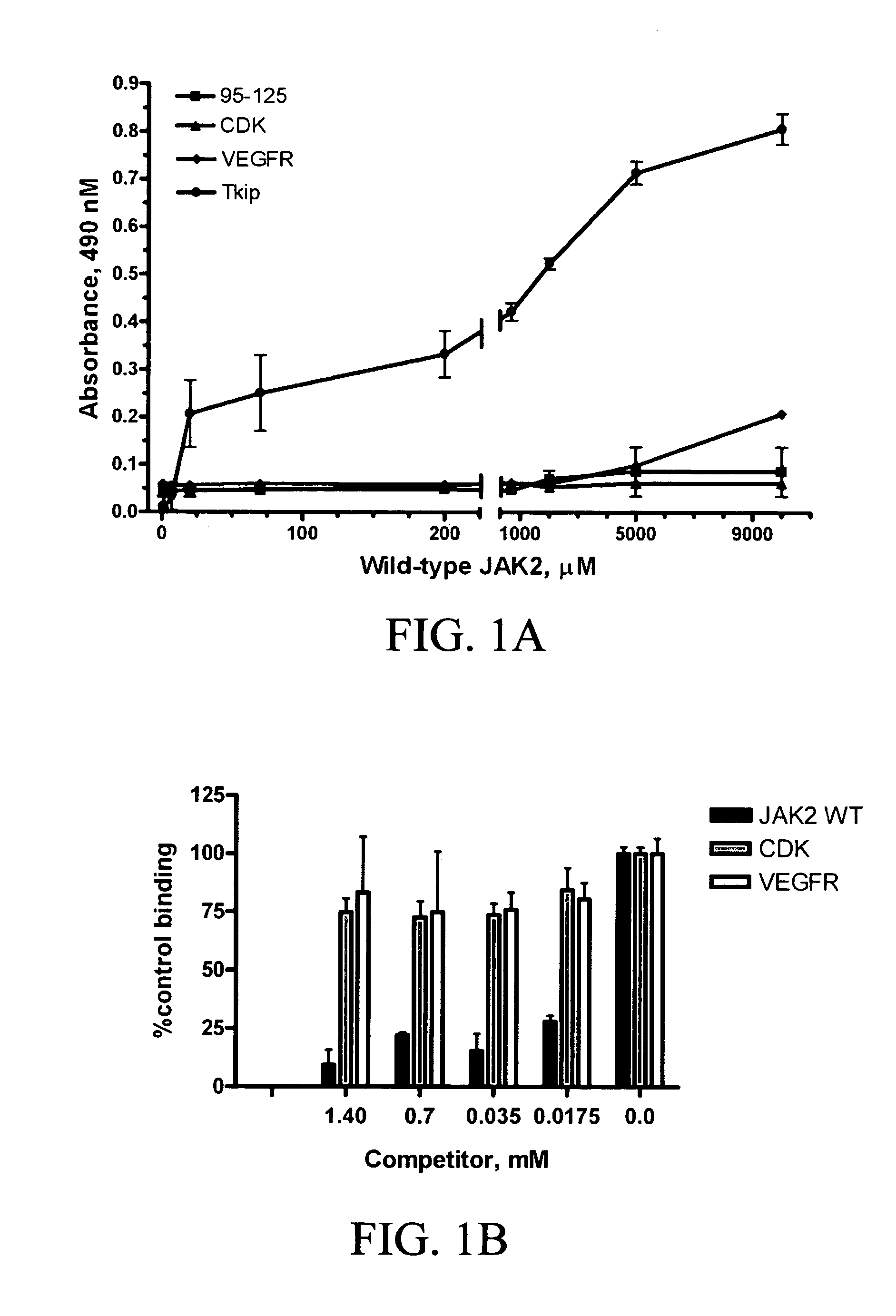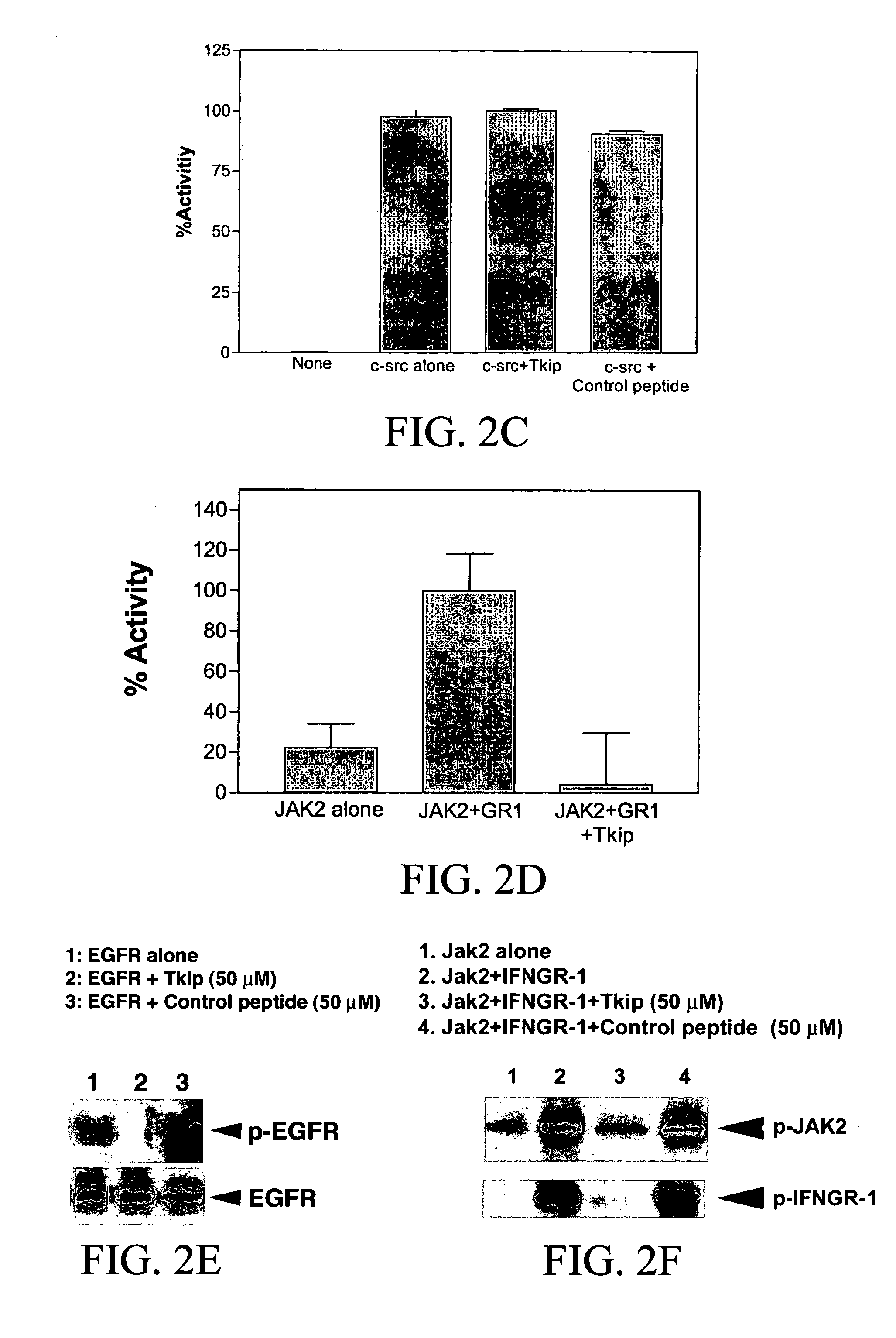Inhibitors of autophosphorylation protein kinases
a technology of autophosphorylation and protein kinase, which is applied in the direction of depsipeptides, peptide sources, peptide/protein ingredients, etc., can solve the problems that tyrosine kinases can often be activated in an uncontrolled fashion, and achieve the effect of shutting down the functioning pathway and inhibiting the enzymatic function of tyrosin
- Summary
- Abstract
- Description
- Claims
- Application Information
AI Technical Summary
Benefits of technology
Problems solved by technology
Method used
Image
Examples
example 1
Binding of Tkip Peptide to Autophosphorylation Peptide Sequence
[0216]The autophosphorylation site of human JAK2 consists of residues 1001LPQDKEYYKVKEP (SEQ ID NO. 2) with 1007Y as the tyrosine autophosphorylation residue that results in activation of JAK2 (Yasukawa et al., 1999). A complementary peptide approach was used to develop a short peptide capable of binding to this site (Villain et al., 2000). The complementarity refers to the hydropathic complementarity, which has been shown empirically to result in peptide / peptide binding. Recently, an algorithm has been developed that specifies the “best” complementarity fit (Fassina et al., 1992). The sequences of several peptides that varied in their complementarity to 1001LPQDKEYYKVKEP (SEQ ID NO. 2) were generated. It was discovered that the best complementary fit did not necessarily result in the best binding to JAK2 peptide (data not shown). Thus, the best binding, which was not the best complementary fit, occurred with complementa...
example 2
Peptide Inhibition of Tyrosine Kinase Autophosphorylation
[0218]Experiments were conducted to determine whether Tkip peptide could inhibit JAK2 autophosphorylation as well as phosphorylation of IFN-γ receptor subunit IFNGR-1. As shown in FIG. 2A, Tkip at 50 μM inhibited both the autophosphorylation of JAK2 as well as JAK2 phosphorylation of IFNGR-1. A control peptide, JAK2 WT, at the same concentration had no effect on JAK2-induced tyrosine phosphorylations. Thus, consistent with Tkip binding to JAK2 WT, it also inhibited JAK2 autophosphorylation as well as JAK2 phosphorylation of IFNGR-1.
[0219]Tkip peptide was also tested for its inhibitory effects against several other tyrosine kinases. VEGFR is involved in the development and growth of the vascular endothelial system (Ferrara et al., 2003). As shown in FIG. 2B, Tkip peptide at 50 μM did not inhibit the autophosphorylation of VEGFR, but under the same conditions completely inhibited JAK2 autophosphorylation as well as JAK2 phosphor...
example 3
Tkip Peptide Dose-Dependent Inhibition of JAK2 and EGFR Autophosphorylation
[0222]Tkip inhibition of JAK2 and EGFR autophosphorylation was compared in a dose-response study. As shown in FIG. 3, Tkip peptide similarly inhibited autophosphorylation of JAK2 (FIG. 3A) and EGFR (FIG. 3B) with 25 to 50 μM significantly blocking JAK2 autophosphorylation and 12 to 25 μM blocking IFNGR-1 phosphorylation by JAK2, while 6 to 12 μM significantly blocked EGFR phosphorylation. Thus, the patterns of dose-response inhibition of JAK2 and EGFR were similar. It is of interest that Tkip inhibited JAK2 phosphorylation of IFNGR-1 at a lower concentration than that for JAK2 autophosphorylation itself. This suggests that Tkip can block JAK2 phosphorylation of a substrate (IFNGR-1) more effectively than the autophosphorylation of JAK2, and that Tkip binds phosphorylated JAK2 more effectively than it does unphosphorylated JAK2.
PUM
| Property | Measurement | Unit |
|---|---|---|
| Immunogenicity | aaaaa | aaaaa |
| Antimicrobial properties | aaaaa | aaaaa |
Abstract
Description
Claims
Application Information
 Login to View More
Login to View More - R&D
- Intellectual Property
- Life Sciences
- Materials
- Tech Scout
- Unparalleled Data Quality
- Higher Quality Content
- 60% Fewer Hallucinations
Browse by: Latest US Patents, China's latest patents, Technical Efficacy Thesaurus, Application Domain, Technology Topic, Popular Technical Reports.
© 2025 PatSnap. All rights reserved.Legal|Privacy policy|Modern Slavery Act Transparency Statement|Sitemap|About US| Contact US: help@patsnap.com



